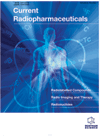- Home
- A-Z Publications
- Current Radiopharmaceuticals
- Previous Issues
- Volume 7, Issue 1, 2014
Current Radiopharmaceuticals - Volume 7, Issue 1, 2014
Volume 7, Issue 1, 2014
-
-
Editorial Review of 2014
More LessAuthors: Sean L. Kitson and Luigi MansiSince the conception of the journal Current Radiopharmaceuticals in January 2008, we have been inundated with a variety of research articles ranging from discussions on the use of radiopharmaceuticals in imaging to drug discovery and targeted therapies. All these articles have been peer reviewed by members of editorial board including guest editors. Here, I would personally like to take this opportunity to thank everyone Read More
-
-
-
Hybrid SPECT/CT Imaging in Neurology
More LessIn recent years, the SPECT/CT hybrid modality has led to a rapid development of imaging techniques in nuclear medicine, opening new perspectives for imaging staff and patients as well. However, while, the clinical role of positron emission tomography-computed tomography (PET-CT) is well consolidated, the diffusion and the consequent value of single-photon emission tomography-computed tomography (SPECT-CT) has yet t Read More
-
-
-
Preparation of Therapeutic Dose of 177Lu-DOTA-TATE Using a Novel Single Vial Freeze-dried Kit: A Comparison with ‘In-situ’ Preparation at Hospital Radiopharmacy
More LessAuthors: Tapas Das, Sharmila Banerjee, Ajit Shinto, K.K. Kamaleshwaran and H.D. SarmaObjective: Patient dose of 177Lu-DOTA-TATE, used for providing radiotherapeutic treatment to the patients suffering from cancers of neuroendocrine origin, could be prepared at the hospital radiopharmacy either ‘in-situ’ or by using freezedried kits. The objective of the present work is to formulate and evaluate a single vial freeze-dried DOTA-TATE kit, which is capable of producing up to 7.4 GBq (200 mCi) dose o Read More
-
-
-
Correlation between Cancer Antigen 15.3 Value and Qualitative and Semiquantitative Parameters of Positron Emission Tomography/Computed Tomography in Breast Cancer Patients
More LessBackground: The association of PET/CT and tumor markers can be considered complementary, since any significant increases of tumor markers can indicate the presence of disease while PET/CT is able to detect and describe the tumor sites. In this retrospective, single-institution study, we determine the correlation between cancer antigen (CA) 15.3 value and qualitative and semi-quantitative PET/CT data in breast cancer (B Read More
-
-
-
Nuclear Imaging and Early Breast Cancer Detection
More LessAuthors: Laura Evangelista and Anna Rita CervinoThe present report discusses about the most important roles of nuclear medicine related to the early detection of breast cancer. We summarily describe the established and emerging diagnostic techniques, their indications and clinical impact for planar and tomographic breast scintigraphy, positron emission tomography (PET)/computed tomography (CT) and positron emission mammography (PEM).
-
-
-
Accelerated Labeling Methods and Syntheses of Radiotracers Utilizing Microfluidic Technology
More LessAuthors: Katherine Hargrove and Graham B. JonesPositron emission tomography [PET] is a powerful nuclear clinical imaging technique used for the detection and treatment of central nervous system (CNS) disorders, cardiovascular diseases, and certain cancers. Due to the often short half-lives of the radiolabeled compounds employed, the availability of relevant tracers is severely limited. Through the use of microfluidic techniques many of the limitations of conventional Read More
-
-
-
Microwave-assisted Radiosynthesis of the Hypoxia Marker 1-α-D-(5- Deoxy-5-[18F]fluoroarabinofuranosyl)-2-nitroimidazole ([18F]FAZA)
More LessAuthors: Piyush Kumar, Raymond Ortlieb, Arjun K. Gupta and Leonard I. WiebeThe routine manufacture of most short-lived positron-emitting radiopharmaceuticals (PERs) involves conventional heating to accelerate the radiolabeling process. Nucleophilic radiofluorination reactions are generally slow at lower temperatures, and are accompanied by thermal decomposition of both precursor and product at higher temperatures. This necessitates HPLC purification and results in lower recovered Read More
-
-
-
18FDG-PET/CT in Traumatic Brain Injury Patients: The Relative Hypermetabolism of Vermis Cerebelli as a Medium and Long Term Predictor of Outcome
More LessPurpose: Both, the constant presence of apparent hypermetabolism of the vermis cerebelli compared to the cerebellar hemispheres in traumatic brain injury, and the presence of a good relationship between the intensity of this sign and the severity of the clinical conditions have been addressed in previous studies. Aim of the present paper is to evaluate the possible correlation between the intensity of the finding and t Read More
-
-
-
[99mTc(CO)3]+ and [99mTcO2]+ Radiolabeled Cyclic Melanotropin Peptides for Melanoma SPECT Imaging
More LessThe melanoma targeting peptides (Ala-triazol)Ac-Re(Arg11)CCMSH and N4-CO-Re(Arg11)CCMSH were radiolabeled with [99mTc(CO)3]+ and [99mTcO2]+, respectively, and examined for in vitro cell binding, in vivo biodistribution and imaging properties. The (Ala-triazol)Ac-Re(Arg11)CCMSH and N4-CO-Re(Arg11)CCMSH were synthesized as protected peptides on resin followed by rhenium cyclization with [(C6H5)3P]2ReOCl3 i Read More
-
-
-
Current Role and Future Perspectives of Radioiodinated MIBG in the Evaluation of Dementia with Lewy Bodies
More LessAuthors: Giorgio Treglia, Luca Ceriani and Luca GiovanellaDementia with Lewy bodies (DLB) is the second most common cause of degenerative dementia after Alzheimer’s disease (AD). To improve the diagnosis of DLB, the latest diagnostic criteria incorporate findings from neuroimaging studies including sympathetic innervation imaging with iodine-123-metaiodobenzylguanidine (MIBG). According to these criteria a decreased MIBG myocardial uptake is an important finding su Read More
-
Volumes & issues
Most Read This Month
Article
content/journals/crp
Journal
10
5
false
en


